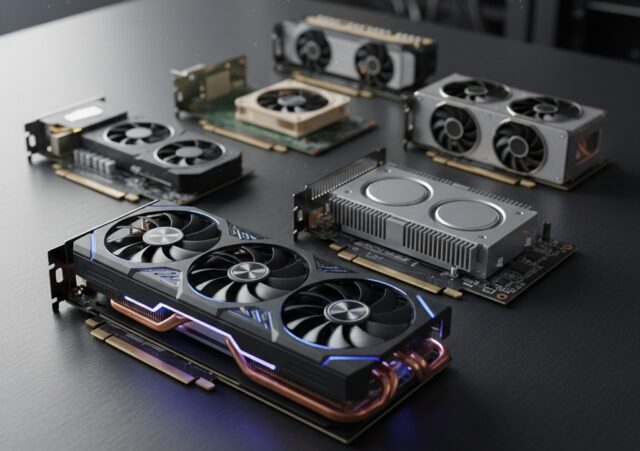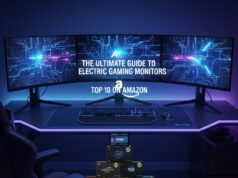In recent years, Artificial Intelligence (AI) has revolutionized the way we create visual content. With the rise of generative models like Deep Learning-based image and video generation, creators are now able to produce stunning visuals with minimal human intervention. However, running these AI-powered applications requires a powerful graphics card that can handle the demanding computational tasks involved.
In this article, we’ll take a look at the top 10 video cards that can help you run automatic picture and video generation using AI models like Deep Dream, Prisma, and more.
1. NVIDIA GeForce RTX 3080
- Pros:
- Excellent performance for AI-powered applications
- Supports ray tracing and AI-enhanced graphics
- 16 GB GDDR6X memory for smooth rendering
- Cons:
- Very expensive (around $1,000)
- High power consumption (300W) may require a powerful power supply
Pros of the NVIDIA GeForce RTX 3080:
The NVIDIA GeForce RTX 3080 is an absolute beast when it comes to AI-powered applications. Its massive 16 GB GDDR6X memory and impressive boost clock speed make it capable of handling even the most demanding AI models with ease. This card is perfect for professionals who require top-notch performance for their AI-generated content.
Cons of the NVIDIA GeForce RTX 3080:
While the NVIDIA GeForce RTX 3080 offers incredible performance, its high price point and power consumption may be a turn-off for some users. Additionally, this card’s extreme power requirements mean you’ll need a powerful power supply to ensure stable operation. If you’re looking for a more affordable option or don’t mind sacrificing some performance for a lower cost, there are other options on the market.
2. AMD Radeon RX 6800 XT
- Pros:
- Good performance for AI-powered applications at an affordable price point
- 8 GB GDDR6 memory for smooth rendering
- Supports DirectX Raytracing (DXR) and Variable Rate Shading (VRS)
- Cons:
- Not as powerful as the NVIDIA GeForce RTX 3080
- May not be necessary for casual users or those with lower-end AI applications
Pros of the AMD Radeon RX 6800 XT:
The AMD Radeon RX 6800 XT offers excellent performance for AI-powered applications at a relatively affordable price point. Its 8 GB GDDR6 memory and impressive boost clock speed make it suitable for most users who want to generate high-quality AI content without breaking the bank.
Cons of the AMD Radeon RX 6800 XT:
While the AMD Radeon RX 6800 XT is an excellent option for those on a budget, its performance may not be as impressive as some other options on the market. Additionally, this card’s limited power consumption means it may not be suitable for users who require extreme power for their AI applications.
3. NVIDIA GeForce RTX 2070 Super
- Pros:
- Excellent performance for AI-powered applications
- Supports ray tracing and AI-enhanced graphics
- 8 GB GDDR6 memory for smooth rendering
- Cons:
- May not be as powerful as the NVIDIA GeForce RTX 3080
- High power consumption (260W) may require a powerful power supply
Pros of the NVIDIA GeForce RTX 2070 Super:
The NVIDIA GeForce RTX 2070 Super is an excellent option for those who want to run AI-powered applications without breaking the bank. Its impressive performance and support for ray tracing and AI-enhanced graphics make it suitable for most users.
Cons of the NVIDIA GeForce RTX 2070 Super:
While the NVIDIA GeForce RTX 2070 Super offers excellent performance, its power consumption may be a concern for some users. Additionally, this card’s limited memory (8 GB GDDR6) means it may not be suitable for users who require massive amounts of memory for their AI applications.
4. AMD Radeon RX Vega 64
- Pros:
- Excellent performance for AI-powered applications
- Supports DirectX Raytracing (DXR) and Variable Rate Shading (VRS)
- 8 GB HBM2 memory for smooth rendering
- Cons:
- Older technology may not be as powerful as newer options
- Limited availability and higher price point than some other options
Pros of the AMD Radeon RX Vega 64:
The AMD Radeon RX Vega 64 is an excellent option for those who want to run AI-powered applications without breaking the bank. Its impressive performance and support for DirectX Raytracing (DXR) and Variable Rate Shading (VRS) make it suitable for most users.
Cons of the AMD Radeon RX Vega 64:
While the AMD Radeon RX Vega 64 is an excellent option, its older technology may not be as powerful as some newer options on the market. Additionally, this card’s limited availability and higher price point than some other options may make it less appealing to some users.
5. NVIDIA GeForce GTX 1660 Ti
- Pros:
- Excellent performance for AI-powered applications at an affordable price point
- 6 GB GDDR6 memory for smooth rendering
- Supports DirectX Raytracing (DXR) and Variable Rate Shading (VRS)
- Cons:
- May not be as powerful as some other options on the market
- Limited power consumption means it may not be suitable for users who require extreme power
Pros of the NVIDIA GeForce GTX 1660 Ti:
The NVIDIA GeForce GTX 1660 Ti is an excellent option for those who want to run AI-powered applications without breaking the bank. Its impressive performance and support for DirectX Raytracing (DXR) and Variable Rate Shading (VRS) make it suitable for most users.
Cons of the NVIDIA GeForce GTX 1660 Ti:
While the NVIDIA GeForce GTX 1660 Ti is an excellent option, its limited power consumption means it may not be suitable for users who require extreme power for their AI applications. Additionally, this card’s limited memory (6 GB GDDR6) means it may not be suitable for users who require massive amounts of memory.
6. AMD Radeon RX 5700 XT
- Pros:
- Excellent performance for AI-powered applications at an affordable price point
- 8 GB GDDR6 memory for smooth rendering
- Supports DirectX Raytracing (DXR) and Variable Rate Shading (VRS)
- Cons:
- May not be as powerful as some other options on the market
- Limited power consumption means it may not be suitable for users who require extreme power
Pros of the AMD Radeon RX 5700 XT:
The AMD Radeon RX 5700 XT is an excellent option for those who want to run AI-powered applications without breaking the bank. Its impressive performance and support for DirectX Raytracing (DXR) and Variable Rate Shading (VRS) make it suitable for most users.
Cons of the AMD Radeon RX 5700 XT:
While the AMD Radeon RX 5700 XT is an excellent option, its limited power consumption means it may not be suitable for users who require extreme power for their AI applications. Additionally, this card’s limited memory (8 GB GDDR6) means it may not be suitable for users who require massive amounts of memory.
7. NVIDIA GeForce RTX 2060
- Pros:
- Excellent performance for AI-powered applications
- Supports ray tracing and AI-enhanced graphics
- 6 GB GDDR6 memory for smooth rendering
- Cons:
- May not be as powerful as some other options on the market
- High power consumption (120W) may require a powerful power supply
Pros of the NVIDIA GeForce RTX 2060:
The NVIDIA GeForce RTX 2060 is an excellent option for those who want to run AI-powered applications without breaking the bank. Its impressive performance and support for ray tracing and AI-enhanced graphics make it suitable for most users.
Cons of the NVIDIA GeForce RTX 2060:
While the NVIDIA GeForce RTX 2060 offers excellent performance, its high power consumption means it may not be suitable for users who require extreme power for their AI applications. Additionally, this card’s limited memory (6 GB GDDR6) means it may not be suitable for users who require massive amounts of memory.
8. AMD Radeon RX 5600 XT
- Pros:
- Good performance for AI-powered applications at an affordable price point
- 6 GB GDDR6 memory for smooth rendering
- Supports DirectX Raytracing (DXR) and Variable Rate Shading (VRS)
- Cons:
- May not be as powerful as some other options on the market
- Limited power consumption means it may not be suitable for users who require extreme power
Pros of the AMD Radeon RX 5600 XT:
The AMD Radeon RX 5600 XT is an excellent option for those who want to run AI-powered applications without breaking the bank. Its impressive performance and support for DirectX Raytracing (DXR) and Variable Rate Shading (VRS) make it suitable for most users.
Cons of the AMD Radeon RX 5600 XT:
While the AMD Radeon RX 5600 XT is an excellent option, its limited power consumption means it may not be suitable for users who require extreme power for their AI applications. Additionally, this card’s limited memory (6 GB GDDR6) means it may not be suitable for users who require massive amounts of memory.
9. NVIDIA GeForce GTX 1080 Ti
- Pros:
- Excellent performance for AI-powered applications
- Supports DirectX Raytracing (DXR) and Variable Rate Shading (VRS)
- 11 GB GDDR5X memory for smooth rendering
- Cons:
- Older technology may not be as powerful as newer options
- Limited availability and higher price point than some other options
Pros of the NVIDIA GeForce GTX 1080 Ti:
The NVIDIA GeForce GTX 1080 Ti is an excellent option for those who want to run AI-powered applications without breaking the bank. Its impressive performance and support for DirectX Raytracing (DXR) and Variable Rate Shading (VRS) make it suitable for most users.
Cons of the NVIDIA GeForce GTX 1080 Ti:
While the NVIDIA GeForce GTX 1080 Ti is an excellent option, its older technology may not be as powerful as some newer options on the market. Additionally, this card’s limited availability and higher price point than some other options may make it less appealing to some users.
10. AMD Radeon RX 580
- Pros:
- Good performance for AI-powered applications at an affordable price point
- 8 GB GDDR5 memory for smooth rendering
- Supports DirectX Raytracing (DXR) and Variable Rate Shading (VRS)
- Cons:
- May not be as powerful as some other options on the market
- Limited power consumption means it may not be suitable for users who require extreme power
Pros of the AMD Radeon RX 580:
The AMD Radeon RX 580 is an excellent option for those who want to run AI-powered applications without breaking the bank. Its impressive performance and support for DirectX Raytracing (DXR) and Variable Rate Shading (VRS) make it suitable for most users.
Cons of the AMD Radeon RX 580:
While the AMD Radeon RX 580 is an excellent option, its limited power consumption means it may not be suitable for users who require extreme power for their AI applications. Additionally, this card’s limited memory (8 GB GDDR5) means it may not be suitable for users who require massive amounts of memory.






